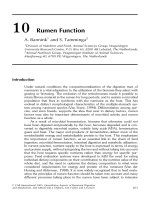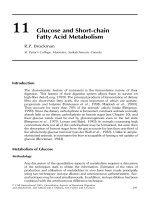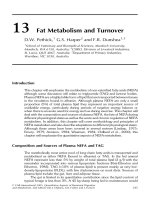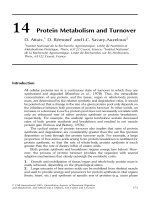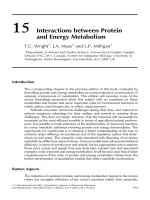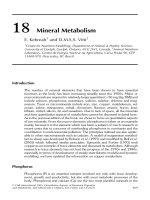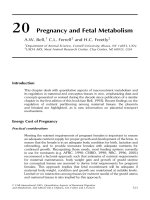Tài liệu Ethical Aspects of Aesthetic Medicine pptx
Bạn đang xem bản rút gọn của tài liệu. Xem và tải ngay bản đầy đủ của tài liệu tại đây (64.75 KB, 6 trang )
7
P.M. Prendergast and M.A. Shiffman (eds.), Aesthetic Medicine,
DOI 10.1007/978-3-642-20113-4_2, © Springer-Verlag Berlin Heidelberg 2011
Ethical Aspects of Aesthetic
Medicine
Urban Wiesing
2
2.1 Introduction
When physicians concern themselves with the aesthetic
aspects of their patients, public opinion varies on the
topic. On the one hand, certain measures are required
in order to improve the aesthetic appearance of a per-
son. They are a normal part of the medical profession.
For example, to reconstruct the deformed face of a car-
accident victim or to give a patient with a serious skin
disease the most “normal” appearance possible
undoubtedly belongs to the art of medicine. On the
other hand, there are several medical procedures that
are concerned with the aesthetics of their patients being
criticized. For example, one could mention television
programs in which physicians help participants to look
more like celebrities (“I want a famous face,” MTV).
Furthermore, there are cases in which physicians per-
formed aesthetic operations obviously too frequently
and with harm to the patient or did not do so in accor-
dance with safety standards [1]. Here the question
arose whether physicians’ participation is ethically
acceptable. The doubts were supported by the fact that
medicine is expanding with the growing number of
aesthetic measures to a field that frequently does not
have anything to do with the treatment of illness any-
more and goes beyond the traditional core of medicine.
At this point, it should be addressed whether and – if
so – under what conditions physicians should perform
aesthetic interventions on their patients.
This question cannot be answered without refer-
ence to the medical profession and its characteristics.
Furthermore, one must systematize the various medi-
cal efforts for the aesthetics of the patient. Only then, it
can be clarified to what extent certain measures are in
accordance with the ethos of the medical profession
and what responsibility physicians have. Aesthetic
operations on children and adolescents as a special
case should be examined as well.
At this point, the question concerning the participa-
tion of the medical profession in certain measures
should be discussed. It should not be asked whether a
person should have an aesthetic operation or not, but
whether physicians should perform it.
2.2 Preliminary Remarks
1. The only measures to be addressed here are those
that exclusively serve aesthetic purposes. If mea-
sures are carried out for medically functional rea-
sons, then there are usually enough reasons to
consider them medically necessary and ethically
acceptable (the patient’s consent as a require-
ment). Furthermore, if medically functional mea-
sures happen to be aesthetically beneficial as well,
like frequently in dentistry, then this additional
characteristic does not provide a reason to doubt
its ethical acceptability.
2. Actions for the sake of one’s own aesthetic
improvement belong to the basic behavior of human
beings. To consciously form the body beyond pure
U. Wiesing
Institut für Ethik und Geschichte der Medizin,
Eberhard-Karls-Universität Tübingen,
Gartenstrasse 47, 72074 Tübingen, Germany
e-mail:
8 U. Wiesing
naturalness under aesthetic aspects distinguishes
human beings from the animal world. They do this
in many ways, be it clothes, cosmetics, care, or sport.
It would therefore not be the activity itself, but the
measures – the medical, especially surgical inter-
vention – which give rise to a special investigation.
2.3 Moral Construction
of the Medical Profession
Why should one ask the question whether physicians
are allowed to take part in this genuinely human action
with all their knowledge and capability? There are
people who wish for better looks and physicians who
can make this wish come true. What should be prob-
lematic about it – it could be asked. In other profes-
sions, expansion does not usually raise critical
questions. So, why in the medical profession?
The medical profession is a unique profession, and
whoever doubts it, can take a look in the “Declaration
of Geneva of the World Medical Association”. There,
the medical profession is committed to one particular
goal, namely to the health of the patients: “The health
of my patient will be my first consideration” [2]. This
goal shapes physicians’ behavior, and for this reason,
the medical profession is a profession and not a busi-
ness. What does this mean? What makes the medical
profession so unique?
Professions have established themselves in all devel-
oped industrial nations and possess the following traits
[3]: They primarily aim for a worthwhile goal and not –
like a business – primarily for the realization of profit.
(That, of course, does not exclude that the members of
certain professions earn their livelihood through their
job.) However, professions are primarily committed to
a socially deemed and important task. The task of med-
icine is clear: It is supposed to maintain and re-establish
health, ease suffering and help sick people. The profes-
sions are geared toward the interests of their clients
or – in medicine – their patients. For this, a high ethos is
expected from the members, an ethos that puts the
patient in the center of the considerations and actions.
Or, as the World Medical Association International
Code of Medical Ethics describes it: “A physician shall
be dedicated to providing competent medical service in
full professional and moral independence, with com-
passion and respect for human dignity” [2]. In profes-
sions, the services frequently have to be locally based
and be personally delivered. They cannot be delegated,
with the exception of assistant physicians. Advertising
is only allowed within limits – at least in numerous
countries – as to not induce demand.
Why is this orientation so important for physi-
cians, why is a high ethos from the members of the
medical profession demanded, why do they have to
work in a patient-oriented fashion? If one puts one-
self in the situation of a patient, then an answer can
be found: people experience various difficulties in
the course of their lives such as health problems, and
it proved to be beneficial as an answer to these con-
tingencies for sick people that the members of cer-
tain professions (in this case the medical profession)
dedicate themselves to the patients’ problems, are
competent and act patient-oriented. Sick people must
expect that the members of the medical profession
know exactly what they are doing, have a command
of their duties and simultaneously use these abilities
to the benefit of the patient. Patients must trust that
physicians possess a certain ethos, a work-related,
humane disposition. Physicians cannot guarantee the
success of a medical measure, but they can guarantee
that they possess abilities and take a certain moral
stance.
Since the patients cannot verify the stance of each
and every member of the profession in advance, they
have to rely on the fact that just because someone is a
member of the profession, certain capabilities and
moral stances can be expected. It is in the sense of pro-
fessionalism, of a binding professional ethos, because
it makes the so-called system of anticipatory trust pos-
sible [4]. A working party on “Doctors and Society
Medical professionalism in a changing world” of the
Royal College of Physicians defined in 2005 medical
professionalism “as a set of values, behaviours, and
relationships that underpin the trust the public has in
doctors” [5]. The patient can expect certain behavior
simply because of the membership in the medical pro-
fession. The system of medicine entitles one to the
expectation. This confidence is certainly not to be
understood as a nostalgically glorifying adjunct to a
service relationship, but is essential in the doctor–
patient relationship. With that, the profession agrees to
a contract with society. “Professionalism is the basis of
medicine’s contract with society. It demands placing
the interests of patients above those of the physician,
setting and maintaining standard of competence and
integrity” [6].
This should also be considered if one wants to
answer the question to what extent physicians should
92 Ethical Aspects of Aesthetic Medicine
be devoted to the aesthetics of their patients. Then, one
should study the measures taken to change the aesthet-
ics of a person to determine whether they threaten the
constitutive element of medicine, namely the “system
of anticipatory trust.”
2.4 Classification of Aesthetic
Interventions
First, the undisputed cases are discussed that were
already mentioned above: there is no doubt that several
aesthetic interventions are compatible with the medi-
cal ethos. As a profession, physicians are committed to
health. When they treat the ill, thereby correcting the
aesthetic drawbacks of a disease, there is no contradic-
tion with the medical ethos.
However, with that the whole area of aesthetic inter-
ventions is not covered for the following two reasons:
1. The concept of disease is fuzzy around the edges; it
also has changed historically. For many symptoms,
it can be difficult to say whether they should be
regarded as a disease or not. The best-known exam-
ples are the symptoms of aging: Are they diseases
or the physiological course of events?
2. Certain aesthetic interventions to correct conditions
are beyond what – despite all the uncertainty – is
widely seen as a disease. How should physicians
face up to that?
In order to assess these aesthetic interventions ethi-
cally, a subdivision is proposed here that is oriented to
the attention of events. Medical interventions for the
purpose of altering the aesthetic appearance can
1. diminish undesired, excluding or negatively per-
ceived attention from other people,
2. increase positively perceived attention from other
people.
We must realistically concede that this distinction is
not clear-cut for all cases. There could be cases in which
both aspects are touched upon. However, this distinc-
tion proves to be helpful for the issue discussed here.
2.5 Medical Ethos and Aesthetic
Activities
The first group: This includes, for example, medical
treatment of disfigurements or of characteristics that
act stigmatizing and often but not always have a disease
reference, which often but not always differs widely
from the average. The treatments are reconstructive in
many cases, inasmuch as they want to restore a “nor-
mal” state as much as possible. With these treatments,
people should get the chance to lead a life free of
excessive, unwanted negatively perceived attention, a
life free of stigmas. Basically, one wants to help them
get to that “normal” level of attention as much as pos-
sible and avoid stigmatization and exclusion. These
measures can be justified by considerations of justice:
It’s about giving people chances for a good life, or, as
the “Central Ethics Commission at the German
Medical Association” recently formulated it, as a
maxim for allocating resources in health care, making
it possible for humans to “participate in social life” [7].
There is no doubt that measures to prevent stigmatiza-
tion – within the scope of good medical treatment – are
compatible with the medical ethos and do not
compromise the medical profession in any way, pro-
vided that they are carried out lege artis. This is also
true when it is a matter of aesthetic, not functional
corrections.
The other group of aesthetic measures, including
operations, however, intends to increase desired, posi-
tively perceived attention from others through physical
changes. In addition, the changed appearance is sup-
posed to contribute to the attractiveness in comparison
with others. Frequently, these operations are supposed
to correct the symptoms of old age or effects of excess
weight. There is usually no sign of disease and no
“medical” indication. The patient’s desire and money
decide on the measure.
What happens in the relationship between physi-
cian and patient in this case? There is no medical indi-
cation and therefore the physician is not responsible
for an indication. The physician is only responsible for
proposing a method by which the patient’s goal should
be achieved and for proper performance. Therefore,
the physician’s responsibility has changed dramati-
cally. Since it has nothing to do with the health of a
patient, the physician is not obligated to perform such
measures. But are physicians not allowed to perform
for this reason? And if they do it, if physicians offer
purely cosmetic measures, even operations, will the
medical profession be compromised?
Simply because of the lacking reference to illness,
trust in the medical profession is not necessarily com-
promised when it comes to purely aesthetic measures.
For example, physicians are already working in areas
beyond illness, whether it be abortion, contraception,
improvement of performance through training in
10 U. Wiesing
sports, etc. However, what needs to be guaranteed to
ensure that the “system of anticipatory trust” is not
compromised?
1. Measures that the patient wants but cannot really
help the patient in any way should not be performed.
For example, if the patient’s desire for a change in
appearance is caused by a serious mental disorder, a
medically obtained change in appearance will prob-
ably not relieve the suffering of the patient. Here, it
is the physician’s duty to recognize this and suggest
other helpful measures such as further discussions
or psychotherapy. The International Code of
Medical Ethics of the WMA states: “A physician
shall act in the patient’s best interest when provid-
ing medical care” [2].
2. The consultation must also be geared toward the
goal of assisting the patient and searching for an
appropriate approach for him or her. The consulta-
tion shall not serve the purpose of “selling” a par-
ticular measure. “Placing the interests of patients
above those of the physician” [6] is one of the fun-
damental principles of professionalism.
3. The patients also have to be thoroughly informed
that there is no medical indication to be found. They
have to be informed in detail about the measure and
must give their free informed consent.
4. The high standards of avoiding harm must be main-
tained. Medical measures generally bear risks, but
the avoidable ones should be avoided, especially
those that come with voluntary operations. Otherwise,
it would go against the basic principle of “setting
and maintaining a standard of competence of profes-
sionalism” [6].
5. Advertising should be limited to factual informa-
tion as not to induce demand.
These conditions must be met in order to exclude
that a measure, which is most likely not helpful, is
implemented, that the patient is forced to do it, is not
sufficiently informed and that preventable damage
occurs. All this would jeopardize the “system of antici-
patory trust” in the medical profession. But, if this is
largely excluded, then the answer to the central ques-
tion of how aesthetic actions jeopardize the medical
profession is: This is not the case, provided that the
orientation towards the patient and the high quality of
consultation and implementation are guaranteed.
Cosmetic medicine and particularly cosmetic sur-
gery expand what medicine has to offer, but they do
not demonstrate any unknown, new dimension of
medical practice. It would certainly give cause for
concern if physicians displayed in their traditional
area (the treatment of diseases) even some of the atti-
tude from aesthetic medicine, namely that only the
will and financial power of the customer can make
something happen. However, provided that this is not
the case for the main medical duty – the prevention,
treatment or alleviation of disease – the medical pro-
fession would with certain cases of cosmetic interven-
tions, in particular of purely cosmetic surgery, only
expand their services. If the medical profession makes
this expansion recognizable, and a high standard of
quality in aesthetic medicine and patient orientation is
guaranteed, there is no reason for a threat to the “sys-
tem of anticipatory trust” and the medical profession
to be seen.
2.6 Aesthetic Measures for Children
and Adolescents?
The suggested distinction between “reducing unde-
sired attention” and “increasing desired attention” is
also supportive for assessing the situation of children
and adolescents. Of course, a clear-cut line cannot
always be found even in these cases. Nevertheless, one
can divide the interventions according to the previ-
ously noted distinction concerning attention to events
into two groups: How should aesthetic medical inter-
ventions, even operations on children and adolescents
be assessed, that are supposed to reduce undesired,
exclusionary, negatively perceived attention from other
people and those intended to increase positively per-
ceived attention?
In the first group, for example, could be operations
on injuries that caused disfigurement or characteristics
that can have a stigmatizing effect. A good example
would be bat ears. Their correction carried out on chil-
dren and adolescents can be justified insofar as one
would like to provide the child or adolescent with the
chance of an unencumbered childhood or adolescence
without frequent, undesired, negatively perceived atten-
tion, without a stigma. Exclusion and teasing should be
prevented. At this particular period in life, social con-
tacts and confidence are extremely important because
they facilitate opportunities for a further good life.
Orientations on a concept of illness in the process are
not helpful and are not even mentioned, for example, at
the surgery on bat ears.
112 Ethical Aspects of Aesthetic Medicine
The assessment looks completely different for
operations or measures that only serve the purpose of
drawing desired, positively perceived attention from
others onto oneself through physical change. With
such operations or measures, children or adolescents
enter a contest for additional attention. The contest is
present anyway and is largely unavoidable, especially
in youth. However, this raises the question as to
whether this contest should be exacerbated by the pos-
sibilities of medicine. There are convincing reasons to
speak against it, especially when it comes to aesthetic
operations.
First, the medical risks should be mentioned: In
addition to the usual medical risks, the results of opera-
tions during childhood or adolescence are more diffi-
cult to be predicted because of their growth. The
possibility of an unwanted result is increased in case of
some surgical procedures. Furthermore, cosmetic
operations and other medical measures confirm and
strengthen the competition for desired, positively per-
ceived attention through physical appearance just by
being yet another available tool. The pursuit of altering
the aesthetic appearance (that does not stop at surgery)
is problematic in two senses: It suggests that we must
be beautiful on the one hand and must be willing to
have cosmetic surgery for beauty on the other. This
could induce increased suffering, while simultaneously
offering services for the reduction of suffering. It would
be more desirable to not dictate new standards and sug-
gest new measures for rule compliance, but to provide
an unencumbered childhood and adolescence without
additional aesthetic pressures. These arguments speak
for a restriction of aesthetic measures and operations
on children and adolescents that only serve the purpose
of increasing the desired attention. Nevertheless, there
are convincing arguments for the avoidance of stigma-
tization of children and adolescents through medical
interventions.
2.7 Conclusions
Medical interventions that are only supposed to
increase the desired, positively perceived attention
from others are not necessary according to medical
ethos. However, they do not go against them, provided
that high quality requirements are guaranteed. The
measures have to be deemed beneficial to the patient in
advance, a patient must be informed and the avoidance
of harm must be guaranteed. Aesthetic measures, espe-
cially operations, which only serve the purpose of
increasing desired, positively perceived attention,
should not be performed on children and adolescents.
Nevertheless, there are convincing arguments for an
avoidance of stigmatization of children and adoles-
cents, even through medically aesthetic measures.
References
1. Mercer N (2009) Clinical risk in aesthetic surgery. Clin Risk
15:215–217
2. />html
3. Taupitz J (1991) Die Standesordnungen der freien Berufe,
Geschichtliche Entwicklung, Funktionen, Stellung im
Rechtssystem. De Gruyter, Berlin
4. Schluchter W (1980) Rationalismus der Weltbeherrschung,
Studien zu Max Weber. Suhrkamp, Frankfurt am Main, p 191
5. />pdf
6. ABIM Foundation. American Board of Internal Medicine,
ACP-ASIM Foundation. American College of Physicians-
American Society of Internal Medicine, European Federation
of Internal Medicine (2002) Medical professionalism in the
new millennium: a physician charter. Ann Intern Med
136(3):243–246
7. Stellungnahme der Zentralen Kommission zur Wahrung
ethischer Grundsätze in der Medizin und ihren Grenzgebieten
(Zentrale Ethikkommission) bei der Bundesärztekammer.
Priorisierung medizinischer Leistungen im System der
Gesetzlichen Krankenversicherung (GKV). Deutsches
Ärzteblatt (2007) 104:A1–5, A2
/>


